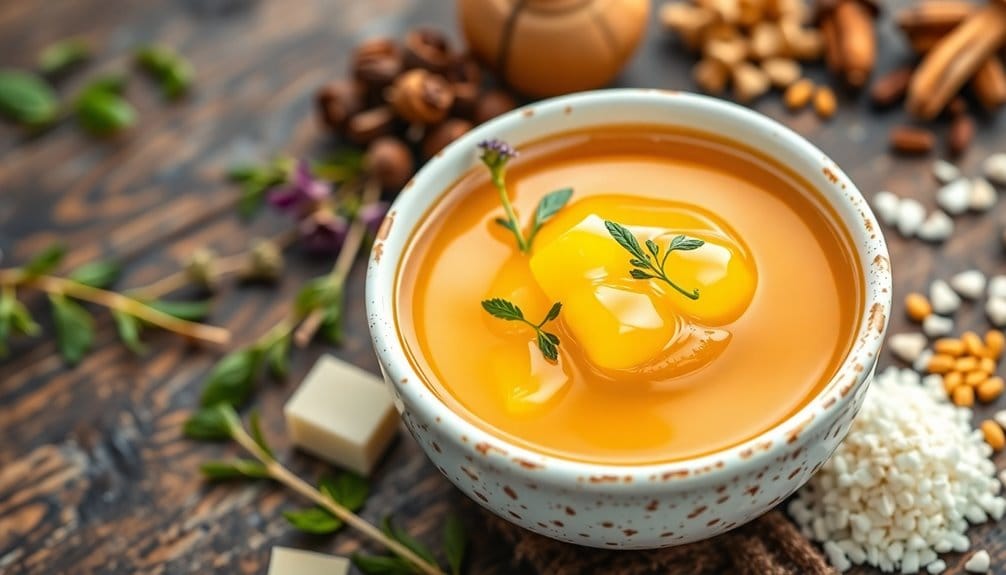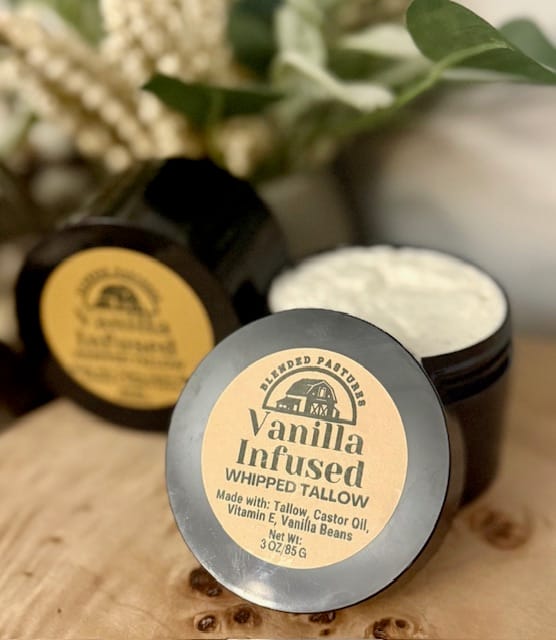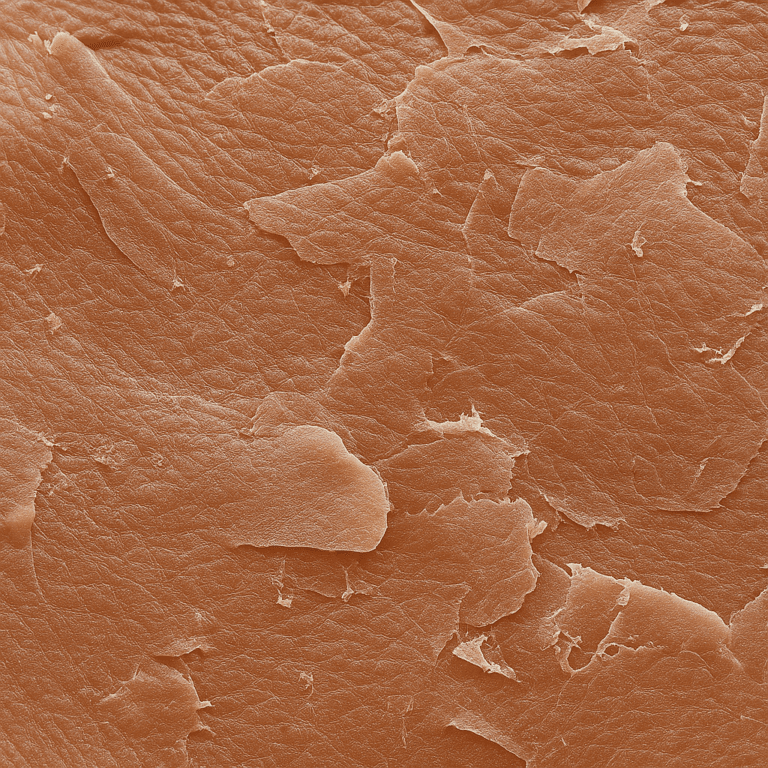You'll find that tallow's rich in essential fat-soluble vitamins A, D, E, and K, which support everything from bone health to immune function. It's packed with beneficial fatty acids like oleic acid (40-50%), palmitic acid (25-30%), and stearic acid (15-20%), plus powerful CLA for inflammation support. Grass-fed tallow offers up to five times more nutrients than conventional sources, making it a powerhouse ingredient. There's much more to discover about this traditional cooking fat's remarkable benefits.
Highlights
- Tallow contains essential fat-soluble vitamins A, D, E, and K, which support overall health and enhance nutrient absorption.
- Oleic acid makes up 40-50% of tallow's fatty acid profile, supporting heart health and reducing inflammation.
- Stearic acid in tallow supports healthy cholesterol metabolism, insulin sensitivity, and maintains stable energy levels.
- Conjugated Linoleic Acid (CLA) in tallow regulates inflammatory responses and supports immune system function.
- Grass-fed tallow provides up to five times more vitamins A, D, E, and K compared to conventional tallow.
Understanding Fat-Soluble Vitamins in Tallow

When you're exploring the nutritional benefits of tallow, you'll find that fat-soluble vitamins are among its most valuable components. Like many in our wellness community, you'll appreciate knowing that tallow is rich in vitamins A, D, E, and K, which your body stores for later use.
These fat-soluble vitamins work together to support your overall health. You'll get the most nutrient absorption when you consume tallow with other whole foods. For example, try adding a dollop of tallow to your roasted vegetables – you're not just making them tastier, you're helping your body absorb those nutrients more effectively. The vitamin K in tallow pairs particularly well with leafy greens, while its vitamin D content supports calcium absorption from dairy products.
The Rich Fatty Acid Profile of Tallow

Although tallow might seem like a simple cooking fat, it's actually packed with an impressive array of fatty acids that your body needs. When you're cooking with tallow, you're tapping into nature's storehouse of essential nutrients that your ancestors relied upon for generations.
Tallow isn't just another cooking fat – it's a nutritional powerhouse that connects us to centuries of traditional wisdom and nourishment.
- Oleic acid (40-50%) – This monounsaturated fat helps support heart health and reduces inflammation
- Palmitic acid (25-30%) – Your body uses this saturated fat for energy and cell membrane structure
- Stearic acid (15-20%) – Known to help maintain healthy cholesterol levels
- Conjugated linoleic acid (CLA) – A powerful fatty acid that supports immune function
The tallow benefits you'll experience come from this balanced mix of fatty acids, which work together to support your body's natural processes. You're getting nutrition that's both traditional and scientifically validated.
Health Benefits of Stearic Acid

Since stearic acid makes up a significant portion of tallow's fatty acid profile, you'll want to understand its unique benefits. You're joining a growing community of health-conscious individuals who recognize this saturated fat as a nutritional powerhouse.
Among natural stearic acid sources, tallow ranks right up there with cocoa butter and dairy products. When you consume foods rich in stearic acid, you're supporting healthy cholesterol metabolism and improved insulin sensitivity. What's really exciting is how stearic acid benefits your body by converting to oleic acid, the same heart-healthy fat found in olive oil. You'll also love knowing that it helps maintain stable energy levels throughout the day, unlike those quick-burning carbohydrates. Plus, it's been shown to support healthy mitochondrial function, which is essential for your overall wellbeing.
Nutritional Comparison With Other Cooking Fats
Understanding how tallow stacks up against other cooking fats will help you make informed choices in your kitchen. When you're comparing cooking oils and traditional fats, you'll find that tallow offers unique benefits that many modern alternatives can't match. Let's explore how tallow compares to other common cooking fats.
Traditional tallow stands out among modern cooking fats, offering exceptional benefits that make it a superior choice for your kitchen.
- Smoke Point: Tallow's high smoke point (400°F) outperforms olive oil (375°F) and matches avocado oil
- Stability: Unlike vegetable oils, tallow remains stable during high-heat cooking and doesn't oxidize easily
- Nutrient Density: Contains more fat-soluble vitamins (A, D, E, K) than most plant-based oils
- Shelf Life: Properly stored tallow lasts longer than most cooking oils, staying fresh for up to one year
You'll find that making the switch to tallow gives you both practical and nutritional advantages in your cooking routine.
Grass-Fed vs. Conventional Tallow Nutrients
When you're choosing between grass-fed and conventional tallow, the source makes a significant difference in nutrient content. You'll find that grass-fed tallow offers higher nutrient density, containing up to five times more vitamins A, D, E, and K compared to its conventional counterpart. It's also richer in heart-healthy omega-3 fatty acids and conjugated linoleic acid (CLA).
The grass-fed benefits extend beyond just nutritional value. The animals' natural diet results in tallow with a better fatty acid profile and more antioxidants. You're getting a purer product that's free from the antibiotics and hormones often found in conventional livestock. If you're looking to maximize the health benefits of your cooking fat, grass-fed tallow is worth the investment. Many home cooks in our community swear by its superior flavor too.
Tallow's Role in Skin Health and Nutrition
Thanks to its unique molecular structure that closely mirrors human skin cells, tallow's becoming increasingly popular in natural skincare. You'll find this traditional fat offers exceptional skin moisturizing benefits while delivering crucial nutrients directly to your skin barrier.
Here's what makes tallow so effective for skin health:
- Contains fat-soluble vitamins A, D, E, and K that support skin cell regeneration
- Rich in conjugated linoleic acid (CLA), which helps reduce inflammation and redness
- Provides palmitic acid and stearic acid, essential for maintaining skin barrier function
- Absorbs quickly without leaving a greasy residue, making it perfect for daily use
When exploring tallow applications, you'll discover it works wonderfully as a facial moisturizer, body butter, or healing balm for dry, damaged skin.
Metabolic Effects of Tallow Consumption
Beyond its topical benefits, tallow's impact on your body's metabolism deserves special attention. When you consume tallow, it engages multiple metabolic pathways that can help support your body's natural energy production. You'll find that tallow's unique fatty acid profile works with your digestive system in ways that modern oils simply can't match.
The dietary impacts of tallow consumption are particularly significant for those of us seeking balanced nutrition. Your body efficiently processes tallow's saturated fats, using them for cellular repair and hormone production. As part of your regular diet, tallow can help maintain steady energy levels throughout the day. Unlike processed fats, it won't cause the energy crashes you might experience with other cooking oils. You'll notice improved satiety and more consistent metabolic function.
Anti-Inflammatory Properties and CLA Content
As you explore tallow's health benefits, you'll discover its impressive anti-inflammatory properties, largely due to its high conjugated linoleic acid (CLA) content. When you incorporate tallow into your diet, you're joining a community of health-conscious individuals who value traditional, nutrient-dense foods.
- CLA levels in tallow from grass-fed animals can be up to 500% higher than in grain-fed sources
- Regular consumption may help reduce systemic inflammation markers in your body
- Tallow ranks among the top natural CLA sources, alongside grass-fed butter and lamb
- The anti-inflammatory benefits become more noticeable after 4-6 weeks of consistent use
You'll find that tallow's unique fatty acid profile works synergistically with its CLA content, potentially offering greater anti-inflammatory effects than either component alone.
Supporting Brain Function With Tallow
The rich array of nutrients in tallow doesn't just fight inflammation – they're powerful allies for your brain health too. When you're looking to support cognitive health naturally, tallow's unique combination of brain nutrients makes it an excellent addition to your diet. The cholesterol in tallow helps maintain your brain cell membranes, while its vitamin D supports neurotransmitter function.
You'll be pleased to know that tallow's omega-3 fatty acids are particularly beneficial for brain development and maintenance. By incorporating just a tablespoon of tallow into your daily cooking, you're providing your brain with essential building blocks it needs to thrive. Whether you're sautéing vegetables or preparing a hearty stew, you're not just cooking – you're investing in your long-term cognitive well-being.
Immune System Benefits of Tallow Nutrients
While many people focus on tallow's culinary uses, its nutrient profile makes it a powerful ally for your immune system. You'll find that this traditional fat source provides essential nutrients that help strengthen your body's natural defenses while supporting nutrient absorption from other foods.
- Vitamin A in tallow helps maintain healthy skin and mucous membranes, your first line of immune defense
- Vitamin D boosts your white blood cell production and enhances immune response
- Vitamin K2 supports immune system function by reducing inflammation and promoting cellular health
- Conjugated linoleic acid (CLA) provides natural immune support by helping regulate inflammatory responses
When you incorporate tallow into your diet, you're tapping into centuries of traditional wisdom about immune health. Its unique combination of nutrients works together to help keep your immune system functioning effectively.
References
- https://www.doctorkiltz.com/tallow/
- https://root-apothecary.com/blogs/news/the-science-behind-root-apothecary-tallow-understanding-the-powerful-nutrients-packed-in-this-product
- https://draxe.com/nutrition/tallow/
- https://batch.libretexts.org/print/Letter/Finished/human-5435/Full.pdf
- https://carnivoreaurelius.com/blogs/carnivore-diet/what-is-tallow




